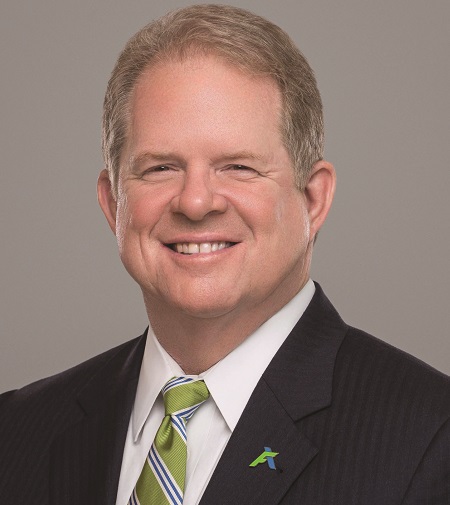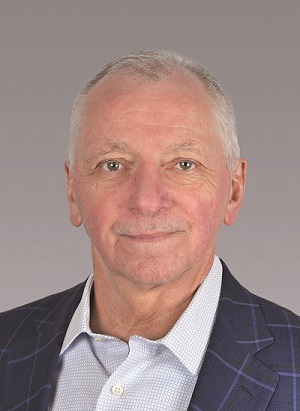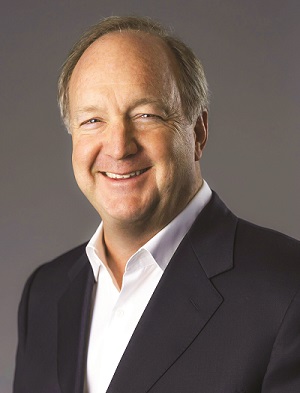


How has turmoil in the banking industry impacted your business?
BRIAN HOLLAND: The banking and finance industry, much like many other industries and sectors, has faced many economic and regulatory challenges since the pandemic. Access to capital, as well as the cost of financing, has been central to these challenges. Our clients have continued to rely on our value-added services, solutions and specialty financing. We’ve provided them pioneering solutions — such as sale-leaseback programs on equipment upgrades and value-added services that are unique to transportation asset management — that help ensure the success regardless of the economic challenges being faced today.
STEVE O’LEARY: Many banks are currently under increased scrutiny by their regulators regarding their loan-to-deposit ratios and the capital required to be held against their loan and lease portfolios. Consequently, these banks are reevaluating their go-to-market strategy, allocating their capital and focusing on holding equipment finance loans and leases for their core customers with full banking relationships. They have also been directed to be more conservative in their new credit client acquisition, requiring lower leverage ratios than they might have tolerated 18 months ago. This has led to an equipment finance vacuum, particularly among their asset-based lending and sponsor finance customers, which non-banks are well-positioned to fill.
BILL STEPHENSON: As we have seen in the past, when U.S. banks are faced with challenges, whether arising from regulatory changes or due to adverse macroeconomic factors, the implications can have a significant effect on our industry, particularly bank-held leasing companies. The upcoming expiration of the Bank Term Funding Program, which was established one year ago in the wake of the Silicon Valley and Signature Bank failures, is a good recent example. It will end in March 2024 and could further tighten capital access and increase borrowing costs for certain U.S. lenders.
At PEAC Solutions, we are fortunate to be a privately-held independent, which typically shields us from most of these challenges. When conditions force many of our bank-held competitors to take a more cautious stance, PEAC views this as an opportune time to prove our value to existing and prospective customers and grow market share.
How has the cost of capital changed over the last year? Have interest rates or shifts in the market impacted your strategy when it comes to raising capital?
HOLLAND: A number of economists believe the Fed[eral Reserve] feels that inflation is becoming more closely aligned with their target and could begin to lower interest rates this year. This would be a sign of relief for those organizations looking to invest in new trucks and equipment, especially as the cost of equipment has become a serious issue for many. Immediately following the pandemic, supply chains made availability a major issue. Today it is no longer about availability and instead more about the cost of entry into new equipment.
Access to capital is a significant focus today that requires a strategy around flexibility. This is a primary reason why companies need to work with partners for a strategic, multi-year acquisition plan built around a methodical and disciplined approach to life cycle management. It is a necessity to have a plan that can adapt to changing market conditions, which is designed to inject more flexibility into the decisions for procurement while assigning stronger fundamentals toward managing the organization’s TCO and bottom line.
O’LEARY: The asset-backed capital markets are a vital source of wholesale funding for mature, scaled commercial finance companies. While there has been a slight increase in the cost of capital in the ABS markets compared to previous years, the demand for bonds backed by large-ticket equipment portfolios remains robust. Investors are increasingly seeking diversification away from consumer ABS and toward sectors like ours, which have historically demonstrated strong performance.
Additionally, the yield curve inversion has introduced a unique dynamic to the market, lasting longer than anticipated by many market participants. However, with the deceleration of the inflation rate and the sustained health of the U.S. labor and employment markets, we anticipate the yield curve to gradually normalize as monetary policy becomes clearer.
STEPHENSON: Similar to other lenders, PEAC Solutions has been experiencing rising borrowing costs and continues to closely monitor market conditions in order to navigate this uncertain environment. When necessary, we will adjust pricing to address changes in our cost of debt and to optimize our risk-reward proposition. That said, our parent company, HPS Investment Partners, is committed to our success and continues to find investors who are attracted by the strong returns that our business model can generate. This has allowed us to continue accessing capital at relatively competitive cost levels.
We’ve seen a greater number of alternative, private capital providers entering the market. What are your thoughts on these sources of capital?
HOLLAND: With all the economic changes occurring, organizations with transportation fleets must utilize every possible resource to properly manage their asset portfolios to create as much financial flexibility as possible. A good majority of private capital providers today continue to only focus on financing without offering many of the additional services needed to truly and properly manage assets. Today’s organizations continue to
seek partners that not only offer access to flexible financing programs, but also have access to boots on the ground services as well as advanced data-driven tools that can help offer insight into their decision making.
O’LEARY: The increase in alternative private capital providers entering the market reflects a significant shift driven by banking dislocations and impending capital regulations. These new entrants have emerged to address the void left by banks unable to meet the growing needs of their customers. While this trend has been underway since the aftermath of the 2008 financial crisis across private credit markets, recent events, including the collapse of major banks, have accelerated its pace in equipment finance.
STEPHENSON: It is opportunistic … the current market conditions create niches for these firms. However, in many cases, their vision is short-term. It is not about developing long-term relationships or building a business model that will thrive for the next 10 years or more, which is our clear focus at PEAC Solutions. I do appreciate that these firms can address certain underserved segments of the market, but once conditions shift, I fear that many of them will inevitably exit.
How do you view the capital markets right now and what is your outlook for 2024?
HOLLAND: Most organizations are paying close attention to the direction of the economy entering 2024, especially with higher interest rates and talk of possibly a reduction of rates. Regardless of the climate for cost of financing, fuel and equipment investment, fleets need to ensure they have a strategic, multi-year procurement plan based on proven data and analytics. This plan ensures each organization is positioned to maximize their TCO no matter the condition of the economy.
O’LEARY: Many banks are cautiously optimistic that some of the pressures they’ve faced may be easing, with hopes that their book and hold budgets will stabilize or potentially increase for 2024. However, not all institutions are receiving clear signals regarding this outlook. As mentioned earlier, the trend of new non-bank equipment finance providers entering the market has been ongoing for the past few years. This influx is expected to intensify competition within the market.
Moreover, private equity firms have increasingly recognized the value of equipment financing products and their potential role within portfolio companies’ capital structures. This heightened awareness is anticipated to drive new and increased volume for the nonbank market, further shaping the competitive landscape in the coming years.
STEPHENSON: Several banks have significantly reduced or shut down their buy desks. For independents that have exposure issues with key strategic obligors, it does create more work because you are forced to find new sources who are willing to take on some of your exposure risk. However, this same dynamic also creates buying opportunities for independents from bank lenders.
How is regulation impacting your business?
HOLLAND: Ongoing regulations affecting Class 8 vehicles continue to alter the landscape for America’s truck fleets. There will be a significant prebuy of Class 8 tractors before the [Environmental Protection Agency’s] upcoming round of emissions regulations targeting diesel exhaust emissions in 2027. The new standards will result in the largest truck prebuy ever, beginning in 2025 into 2026, with the cost of diesel trucks increasing between $25,000 and $30,000 more per unit. Truck fleets need to take a proactive, data-driven approach to their procurement cycles by planning over these next three years to achieve a lower total cost of ownership while lowering their emissions.
O’LEARY: To date, regulation in the large-ticket commercial equipment finance sector has remained relatively stable. However, we maintain a proactive stance in monitoring the regulatory landscape closely to anticipate any potential changes that may impact our operations. We collaborate with legal counsel and closely monitor updates from the [Equipment Leasing and Finance Association] to ensure we stay informed of any developments or proposed changes.
STEPHENSON: Whether you are an independent, captive or bank-held lessor, no one is immune to the growing slate of regulations or the related reporting and disclosure requirements. As we have seen, keeping pace with this fast-changing environment can create significant operational and process challenges as well as increased costs. More importantly, how these requirements will impact the customer experience is not always ‘top of mind,’ which to me is a big miss for our industry. If you make it too difficult for your customers to engage and conduct business, they will migrate to lending products that they perceive as being more user-friendly.
At PEAC Solutions, we have been relatively nimble in developing and implementing solutions that meet the needs of both the regulator and our customer. That aside, the level of effort can sometimes dilute the ability to invest in other key areas of our business. Nevertheless, as an independent lessor, I feel rather fortunate relative to the burden carried by our bank-held counterparts.
Take, for example, when Basel III Endgame goes into effect. We will see stricter capital requirements placed on banks with over $100 billion in assets, which in turn will alter their market and investment strategies, product development, credit conditions and customer pricing. I do think these changes will create some new opportunities for the independents.
How are you approaching investments in your technology infrastructure today?
HOLLAND: Fleet Advantage is well known throughout the industry as leading with innovation and developing pioneering analytics that help organizations maximize their sustainability in operations, while also delivering the lowest total cost of operations.
Fleet Advantage offers a total cost of ownership tech stack that powers advanced analytics and business intelligence to help America’s corporate transportation fleets leverage data technology, asset management and flexible financing to identify and act upon vehicle obsolescence while sustainably driving down operational costs and increasing profit levels. The combination of data analytics and flexible lease finance options are proving to be a key strategy in helping companies determine the right adoption method for these newer vehicles.
O’LEARY: Since our inception in 2021, we have prioritized the development of an integrated technological framework, leveraging the advantage of starting fresh without the burden of legacy systems, conversions, or migrations. As a modern commercial finance company, Clarus has engineered a robust and scalable infrastructure that looks beyond our current needs while also anticipating future growth and expansion. We continually assess new technologies and best practices to ensure that our systems infrastructure remains secure, efficient and scalable.
STEPHENSON: Over the last two years, PEAC Solutions has heavily invested in enhancing our technology infrastructure and digital tools. The focus has been on enhancing the customer experience and making it easier to do business with PEAC, as well as making changes to accommodate and support the emerging regulatory data requirements.
One of our key tenets is ‘never stop developing,’ which is essential in our fast-paced market where customer expectations continue to grow. We recently deployed a new front-end vendor partner portal that will be a real game changer in terms of convenience and ease of use. We also recently upgraded our back-end lease systems. Finally, we launched a new inventory finance product that will soon be supported by DataScan RFID technology to
deliver real-time inventory tracking.
Another equally important tenet is, “cutting edge technology with a human touch.” Our “partner ambassador” roles provide a consistent point of contact to our key vendor partners. When a deal falls out of the digital process and requires manual intervention or other questions arise, we make sure that there is a real person available to support our customers.
What is your outlook for equipment finance in the year ahead?
HOLLAND: Looking ahead to the remainder of 2024, interest rates and the cost of money will continue to be in focus. Companies with transportation fleets must rely on partners with access to proven data so they can make smart, informed decisions that will have longterm benefits without financial missteps. They must have a larger focus on their business above and beyond what the Fed’s actions are. They must manage their life cycles with the right strategy and multi-year procurement plan.
O’LEARY: Clarus maintains a positive outlook for the equipment finance landscape in the upcoming year. We anticipate continued growth and stability across the sectors we serve, driven by several key factors. First, we anticipate sustained demand for equipment across various industries as businesses strive to modernize and reshore their operations. Additionally, favorable economic conditions and more transparent monetary policies are expected to fuel investment and expansion initiatives, further driving the need for equipment financing solutions. We are committed to leveraging our expertise and resources to support our clients in achieving their objectives, fostering growth and driving economic progress in the year ahead.
STEPHENSON: I start every year with the same view: optimism over what my team can directly control. However, I have been doing this long enough to temper that optimism relative to external factors. This is an election year, which tends to bring volatility to the market, but with inflation easing and U.S. economic growth forecasted at 2% or more, there is much to be happy about.
I was also pleased to see the most recent U.S. small business outlook, where positive sentiment outweighed negative for the first time in two years. Roughly two thirds of the surveyed small business owners were bullish about expected revenues, more than half planned to hire additional employees and one third intended to increase their fixed investments in 2024. Typically, those actions translate to increased activity for our industry, and the early results for 2024 are already showing year-over-year growth.
Any final thoughts?
HOLLAND: This is a fascinating time in our industry with the introduction of emerging technologies, new safety features and alternative fuel vehicles juxtaposed against ongoing environmental regulations, supply chain disruptions, higher interest rates and rising equipment costs. Although there are numerous economic and regulatory challenges facing companies today, there are opportunities in every market.
STEPHENSON: I have been part of our proud industry for over 35 years, and I still get so much positive energy from building a successful business and working with our next generation of leaders to realize a vision. We have assembled a great team of professionals at PEAC Solutions who continue to inspire me with their passion for innovation and focus on our customers.
In any business, if you can deliver the right products, enabled by innovative technologies and supported by the best people, you will always be on the path to success. We have all these essential ingredients coming together at PEAC, and I am confident that we will continue to deliver great value to our customers and our shareholders. •
No categories available
No tags available